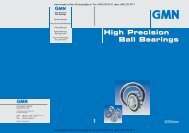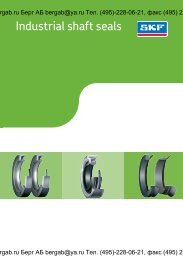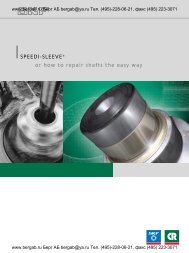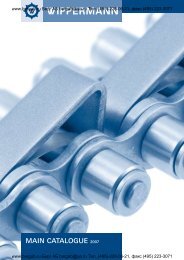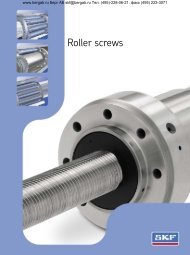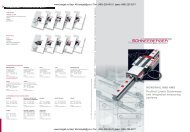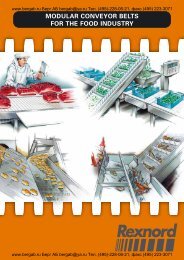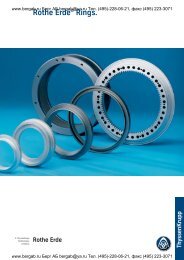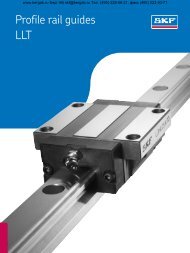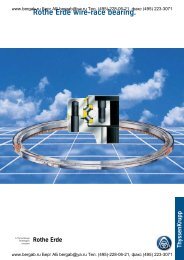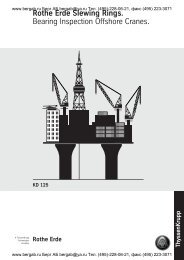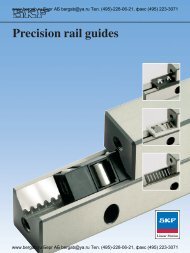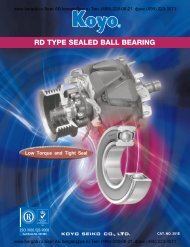Chains
Chains
Chains
You also want an ePaper? Increase the reach of your titles
YUMPU automatically turns print PDFs into web optimized ePapers that Google loves.
Product<br />
Handling<br />
www.bergab.ru Берг АБ bergab@ya.ru Тел. (495)-228-06-21, факс (495) 223-3071<br />
Reducing build up of static electricity<br />
In dry applications where products are being conveyed on plastic chains, especially when accumulation occurs, sometimes an electrostatical charge<br />
can be built up. This electrostatical charge can be inconvenient. It can cause attraction of dust and dirt or an electrical shock when somebody touches<br />
the conveyor or a product. It could also cause disturb to sensitive control devides.<br />
In some cases, the electrostatical charge can even be dangerous. It is easy to image what a discharge in the shape of a spark can cause in explosive<br />
environments.<br />
To reduce the risk of built up of electrostatical charges, two types of precautions can be taken : passive neutralisation and active neutralisation.<br />
- Passive neutralisation means that the electrical charge is avoided by grounding the complete conveyor (chains, wearstrips, frame and components).<br />
- Active neutralisation means that a positive electrostatical charge is neutralised by negative ions. An easy method is blowing ionised air over the chain<br />
and product.<br />
The best way to eliminate build up of static electricity is using steel chains instead of plastic chains. However this is not always possible. Therefore<br />
Rexnord has Anti Static plastic chain in the programme. This available material is electrically conductive.<br />
Note<br />
The Anti Static chain must be used in combination with grounded metal wearstrips.<br />
The AS-material that is used for anti static chains has the following properties<br />
Property<br />
Surface resistance<br />
Volume resistance<br />
AS Polyacetal<br />
≤ 5 • 10 3 Ω/<br />
≤ 10 3 Ω.cm<br />
Standard Anti static material by DIN 53482<br />
≤ 10 9 Ω/<br />
≤ 10 8 Ω.cm<br />
Other precautions to reduce the risk of electrostatical charges can be :<br />
- Apply lubrication if possible;<br />
- Use anti-static or metal wearstrips, guiderails etc. wherever possible and make sure all metal parts are grounded;<br />
- Avoid product accumulation;<br />
- Avoid slip contacts (make sure that idlers and return rollers are rotating).<br />
Calculate product stability<br />
Each product has a maximum value for acceleration. Start-stop or stop-start conditions are related to the product stability. There are formulas to<br />
calculate the stability of a product. On a basis of the outcome of the calculations, it is possible to determine if a 90° deadplate transfer or a Dynamic<br />
Transfer System can be used or whether a Magnetic System is the only suitable solution. Of every product a so-called critical friction coefficient can<br />
be calculated. This critical friction coefficient is the quotient of the radius of the base and the height of the<br />
centre of gravity.<br />
In formula :<br />
f crit = R/H<br />
The critical friction coefficient thus calculated must be compared with the real friction coefficient which is valid<br />
in practice (f real). The real friction coefficient strongly depends on product and conditions. It would be best to<br />
measure the real friction coefficient for the application in question.<br />
H<br />
This has been done numerous times at the Rexnord test centre. Experience has shown that, for the same<br />
product and in the same conditions, the friction coefficient can still vary within a differential of 30%.<br />
R<br />
Now, f crit and f real must be compared with each other. The criteria is that if f crit > f real, the stability of the<br />
product is sufficient. This means that the product will remain standing stable, even when it is subject to large<br />
variations in speed. It will be obvious that obstacles in the conveyor, such as a raised edge for example, still have to be avoided. Please take into<br />
account that dirt affects the friction coefficient in practice. Besides, the lubrication may not always be optimum.<br />
If f crit < f real, this does not immediatly imply that transport is not possible. In order to guarantee the stability, however, a maximum variation in speed to<br />
which the product can be subjected without tipping must be calculated. In a formula :<br />
V lim = √ 2.g. (√ H 2 + R 2 – H)<br />
V lim = Maximum variation in speed [m/s]<br />
R = Radius of the base<br />
[m]<br />
H = Height of the centre of gravity [m]<br />
g = Gravitational acceleration [m/s 2 ]<br />
With a deadplate and Dynamic Transfer System, it may be assumed that the<br />
speed of the product will be reduced to almost nil, after which it will be transfered<br />
continuously at the full speed of the "outgoing" chain. The speed of the outgoing<br />
chain must therefore be lower than V lim to allow for a deadplate transfer.<br />
www.bergab.ru Берг АБ bergab@ya.ru Тел. 112 (495)-228-06-21, факс (495) 223-3071



